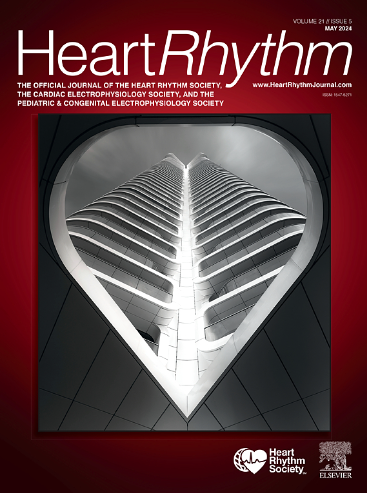在血压计中使用新型机器学习算法检测心房颤动的诊断准确性
IF 5.6
2区 医学
Q1 CARDIAC & CARDIOVASCULAR SYSTEMS
引用次数: 0
摘要
背景:早期发现心房颤动(房颤)是预防中风的关键。内置房颤筛查功能的血压计(BPM)可在家中进行早期检测。最近,两款血压计(HEM-7371T1-AZ 和 HEM-7372T1-AZAZ,OMRON HEALTHCARE Co.它们的心房颤动筛查功能采用了一种结合了机器学习的算法,有望提高诊断准确性:为了评估该房颤筛查功能的性能,我们在美国的五个地点进行了一项多中心前瞻性临床研究:本研究共招募了 559 名受试者,其中房颤受试者 267 名(房颤队列),非房颤受试者 292 名。通过两台欧姆龙 BPM 和一台百略 BPM(BP 3MX1-3,WatchBP Home A,百略公司)对所有受试者进行房颤筛查,并同时记录 12 导联心电图进行对比。所有 12 导联心电图均由一名获得认证的心脏病专家判读,该专家对 BPM 结果视而不见。计算了诊断房颤的敏感性、特异性和准确性:Omron HEM-7371T1-AZ BPM 的灵敏度为 95.1% [95% CI 91.8-97.4],特异度为 98.6% [95% CI 96.6-99.7],准确度为 97.0% [95% CI 95.2-98.2]。欧姆龙 HEM-7371T1-AZAZ BPM 也获得了相同的结果。结论:这些数据支持家庭和专业人员使用 BPM(灵敏度 78.5% [95% CI 73.1-83.3],特异性 97.6% [95% CI 95.1-99.0],准确性 88.4% [95% CI 85.5-91.0]):这些数据支持在家庭和专业人员中使用这些新型欧姆龙 BPM 检测房颤。本文章由计算机程序翻译,如有差异,请以英文原文为准。
Diagnostic accuracy for detecting atrial fibrillation using a novel machine learning algorithm in a blood pressure monitor
Background
Early detection of atrial fibrillation (AF) is key for preventing strokes. Blood pressure monitors (BPMs) with built-in AF screening features have the potential for early detection at home. Recently, 2 BPMs (HEM-7371T1-AZ and HEM-7372T1-AZAZ, Omron Healthcare Co., Ltd.) that share a novel AF screening feature have been developed. Their AF screening feature utilizes an algorithm that incorporates machine learning, with the potential to improve diagnostic accuracy.
Objective
The purpose of this study was to evaluate the performance of this AF screening feature in a multicenter, prospective clinical study at 5 sites in the United States.
Methods
A total of 559 subjects were enrolled for this study: 267 in AF cohort and 292 in the non-AF cohort. AF screening was performed in all subjects by the 2 Omron BPMs and by 1 Microlife BPM (BP 3MX1-3, WatchBP Home A, Microlife Corp.), and a simultaneous 12-lead electrocardiogram (ECG) was recorded for comparison. All 12-lead ECGs were interpreted by a board-certified cardiologist who was blinded to the BPM results. Sensitivity, specificity, and accuracy for the diagnosis of AF were calculated.
Results
Omron HEM-7371T1-AZ BPM had sensitivity of 95.1% (95% confidence interval [CI] 91.8%–97.4%), specificity 98.6% (95% CI 96.6%–99.7%), and accuracy of 97.0% (95% CI 95.2%–98.2%). Equivalent results were obtained with the Omron HEM-7371T1-AZAZ BPM. This compared favorably to the Microlife BPM (sensitivity 78.5%, 95% CI 73.1%–83.3%; specificity 97.6%, 95% CI 95.1%–99.0%; accuracy 88.4%, 95% CI 85.5%–91.0%).
Conclusion
These data support both home and professional use of these novel Omron BPMs for the detection of AF.
求助全文
通过发布文献求助,成功后即可免费获取论文全文。
去求助
来源期刊

Heart rhythm
医学-心血管系统
CiteScore
10.50
自引率
5.50%
发文量
1465
审稿时长
24 days
期刊介绍:
HeartRhythm, the official Journal of the Heart Rhythm Society and the Cardiac Electrophysiology Society, is a unique journal for fundamental discovery and clinical applicability.
HeartRhythm integrates the entire cardiac electrophysiology (EP) community from basic and clinical academic researchers, private practitioners, engineers, allied professionals, industry, and trainees, all of whom are vital and interdependent members of our EP community.
The Heart Rhythm Society is the international leader in science, education, and advocacy for cardiac arrhythmia professionals and patients, and the primary information resource on heart rhythm disorders. Its mission is to improve the care of patients by promoting research, education, and optimal health care policies and standards.
 求助内容:
求助内容: 应助结果提醒方式:
应助结果提醒方式:


